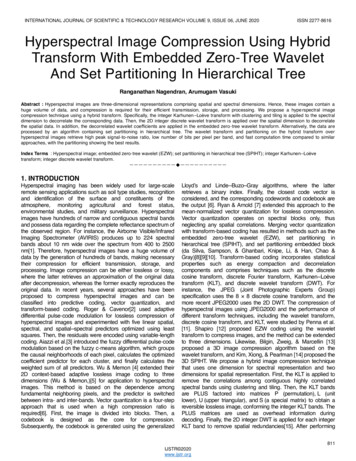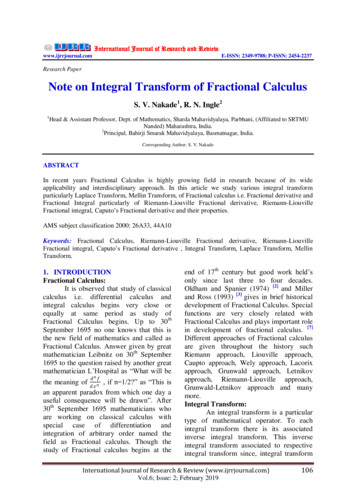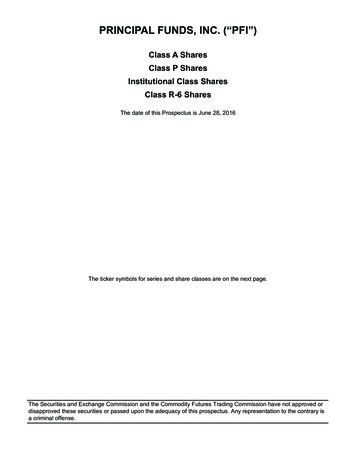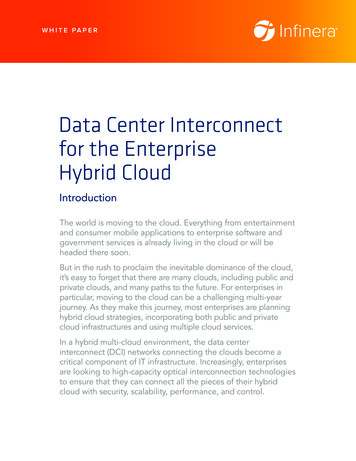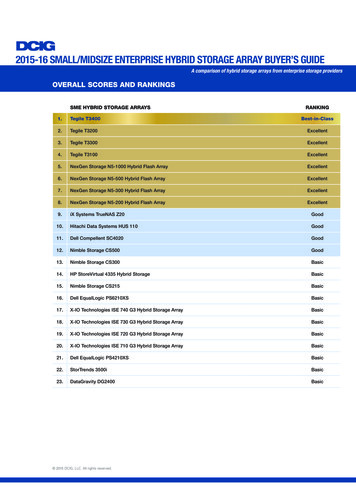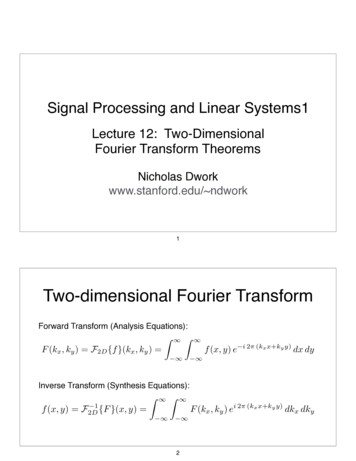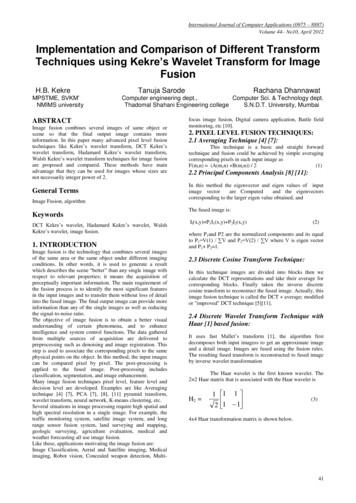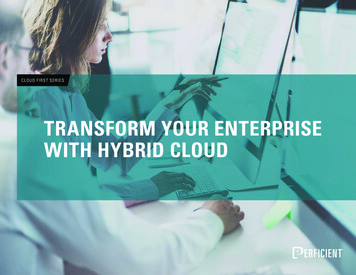
Transcription
TRANSFORM YOUR ENTERPRISEWITH HYBRID CLOUD
Cloud computing continues to gain acceptance as anintegral piece of modern information technology anddigital transformation strategy, shifting budgets andstrategies towards disruptive solutions. Accordingto research firm IDC, the year 2016 alone will markan 11% shift of budgets away from traditional ITdelivery towards various types of cloud computingtechnologies as a delivery model.Most likely, your organization is exploring cloudcomputing solutions to drive innovation and remaincompetitive in a global market. With so manyofferings on the market, deciding on a strategy anda solution can be daunting. You’re not alone. Morethan 60% of enterprises are on that journey as well,expecting to have at least half of their infrastructurewithin the cloud by 2018.Relatively speaking, cloud computing is still in itsinfancy. In its Digital Transformation Maturity ModelBenchmark released in 2015, IDC found that 65%of organizations were still exploring or developinggoals around their interests in digital technologieslike cloud. Organizations that have already movedto the cloud are contending with the challenges ofmigration, choosing between public, private, andhybrid deployments.With many organizational assets still not havingreached their end of life, many CIOs are hesitant tomove directly to public cloud, choosing instead on amix of solutions, otherwise known as hybrid cloud.
HYBRID CLOUD: MORE THAN A MOVEMENTHybrid cloud is a computing environment which uses a mix of on-premisesprivate cloud and third-party public cloud services with orchestration between thetwo platforms. Organizations commonly adopt hybrid cloud to serve emergingcustomer requirements in an agile, innovative setting that does not compromiseexisting technology assets. In many ways, hybrid cloud serves as a bridge tocomplete cloud adoption, and many firms are going that route. In fact, Gartnerreports that 50% of enterprises will be using hybrid cloud by 2017.With growth so essential for economic longevity and survival, hybrid cloud servesas the centerpiece of possibilities. IDC predicts that by 2018, 50% of largeenterprises will leverage cloud platforms to grow anywhere between 100 to1,000 fold.Of the three types of cloud deployments, hybrid cloud is the most favoredamong organizations, as indicated by IDC in the FutureScape report released inNovember, 2015. Hybrid is favored due to its versatility in combining on-premisesand public cloud solutions which offer development teams portability, continuousdevelopment, security services, data localization, and operational visibility andmanagement. The emergence of hybrid cloud strategies has allowed manytechnology and development teams to adopt DevOps, an agile collaborationbetween information technology and operations.WHY SHOULD YOU CONSIDER THE HYBRID CLOUD?If you’re looking for ideas on how to grow your business with hybrid cloud, thisguide provides a few growth strategies through several practical applications.1.Flexible usage model – pay as you go2.Transition capital costs to operations costs3.Improved business agility and functions4.Automation of development and deployment for rapid innovation5.Ease of adoption with a mix of on-premise private cloud and publiccloud solutions
Reason #1OPTIMIZATION OFTECHNOLOGY RESOURCESKeeping pace with business demands and competition is difficult.The market can transform in an instant, depending on the newsor the season, and it expects services to be highly availableand stable. As a result, you must remain agile and leveragetechnologies that allow you to stay online even in the moststrenuous of situations.The changing process of technology resource management andthe hybrid cloud has given rise to the term “cloudbursting,”where workloads are temporarily migrated to a different cloudenvironment to meet demand. In a hybrid cloud scenario,cloudbursting would see the steady state handled by a fixedprivate cloud environment and any significant changes in demandhandled by resources on the hybrid cloud.Besides cloudbursting, the hybrid cloud also facilitates theoptimization of technology resources in disaster recovery.For example, you can keep its production environment in theprivate cloud while maintaining and replicating data in a recoveryenvironment in a second cloud environment. Such a configurationnot only provides you significant cost savings in data recovery, butalso provides a dramatic improvement in application availability.Optimize use of technology resources on the hybrid cloud by: Leveraging cloudbursting to handle intermittent spikes inworkloads to meet demand Complementing a private cloud deployment to provide quickdata recovery and high application availability Creating a test ground to introduce new technologiesand test potential use cases
Reason #2HYBRID INFRASTRUCTURE ANDAPPLICATION MANAGEMENTThe fundamental components of every enterprise lie ininfrastructure, which includes hardware like servers, storage,networking components, and virtualization. Cloud infrastructureservices have gained popularity over the past few years, inpart because of the costly nature of on-premises hardware.As companies undergo technology refreshes, they realize thatpurchasing extra infrastructure to cover occasional spikes in usage isneither financially savvy nor practical.While hybrid cloud has become popular, it still will not replaceexisting legacy infrastructures. Rather, hybrid cloud complements anon-premises infrastructure by allowing the extension of pre-existinghardware and even software that requires increased bandwidth tooperate. Gartner expects adoption of infrastructure cloud services togrow at a 29.1% annual growth rate through 2019.Finally, lying beyond infrastructure is the emerging trend ofcloud containers. Cloud containerization is the next step abovevirtualization and allows for the isolation of software and itsdependencies at the kernel level of an operating system in a virtualenvironment. For information technology and development teams,containerization is advantageous as applications become moreportable, updates are more agile, and development environments aremore flexible to changes. This allows for better development timesand a quicker time to market.Make the most of hybrid infrastructure by: Mixing appropriate cloud and on-premises technologies toincrease flexibility and lower costs Considering cloud containerization to maximize softwaredevelopment optimization
Reason #3COGNITIVE CLOUDData and analytics have become a salient priority across all industries, from theemerging Internet of Things (IoT) vertical to cognitive solutions. Both solutionsallow you to serve your customers in new ways through new experiences.Companies looking to maximize their analytics and data gathering activities lookto their information technology department as the first step to creating acompetitive advantage.Hybrid cloud serves as the foundation for an effective analytics strategy, due tothe required support around varying workloads. Combined with interconnectedapplications stored on various Software-as-a-Service (SaaS) applications anddemographic data from third-party sources, hybrid cloud offers the flexibilityneeded to develop predictive models and create customer personas in a costeffective manner. IDC expects the analytics market to grow 21.7% through 2020as executives see increased value.Finally, hybrid cloud and analytics have enabled the arrival of cognitive cloud, orthe simulation of human thought processes in a computerized model. Cognitivecloud solutions take advantage of self-learning systems that use data mining,pattern recognition, and natural language processing to drive informationtechnology towards automation without requiring human assistance. Withespecially large data sets, you can efficiently come to conclusions, make businessdecisions, and predict the future with relative accuracy.Leverage the analytics and cognitive cloud to: Build predictive models that enable deeper insight on customerinterests and behaviors Utilize cognitive capabilities to drive analytics automation for better decisionmaking Connect various software applications to create rich data insights
SPOTLIGHT: PERFICIENT’S HYBRIDCLOUD VALUE-ADDWe understand the value of hybrid cloud and help you adopt theappropriate solutions from strategic planning through implementation. Wecombine our custom cloud native and migration strengths with DevOps toprovide an end-to-end solution, that impacts organizational change aroundpeople, processes, culture, and technology. With expertise in leading cloudplatforms such as IBM Bluemix, Amazon Web Services, Microsoft Azure,Dell Boomi, and Salesforce App Cloud, we can help you find the optimalcloud solution for your organizational challenges and environment.Our philosophy is rooted in value engineering, a systematic method aimedat improving the value of goods and products characterized as a ratio offunction over cost. With the accelerated transformation, solution costreductions, and innovation within the cloud industry expected to continuefor several years, the only criteria for evaluating cloud solutions requires athorough examination of long-term organizational value.INNOVATION LABWe empower hybrid cloud migration with our industry-leading InnovationLab. Organizational stakeholders can be overwhelmed with the availablecloud options, so our experts assist with choosing the right platform,assessing technology benefits, delegating organizational roles, technologymigration, and cost-effective implementation. In a 10-to-16-week periodbroken down into three phases (discovery, agile realization, adoptionplanning), you will gain clarity on your cloud adoption platform strategy anddesign a minimum viable product user story for the cloud platform you planto use.IMMERSION SOLUTIONThe Immersion Solution is our migration-as-a-service solution for clientsinterested in using IBM Bluemix, boosting in-cloud application efficiencynearly 40% over standard migration processes. Built on Bluemix, Softlayer,and UrbanCode, the Immersion Solution reduces the cost and increasesthe velocity at which existing on-premises information technology can bemigrated through continuous delivery, validation, and connectivity. Oursuccessful development of this solution earned us the 2016 IBM BeaconAward for Outstanding Enterprise Cloud Solution at the IBM PartnerWorldLeadership Conference.Perficient’s Immersion Solutionearned the 2016 IBM Beacon Awardfor Outstanding Enterprise CloudSolution at the IBM PartnerWorldLeadership Conference.
WHY PERFICIENT?There is no doubt that hybrid cloud has become a strategicinvestment, providing the foundation for application management,cognitive cloud, and technology optimization. For savvy technologyexecutives, exploring the benefits and advantages are critical tostaying relevant in a global market. If you’re interested learningmore about how these solutions can assist your organizationalneeds, send us an email at sales@perficient.com for moreinformation and a sp?containerId sp?containerId .idc.com/getdoc.jsp?containerId prUS40560115
Let Perficient help you onyour cloud-first journey:DOWNLOAD GUIDEON-DEMAND WEBINARSCLOUD SUCCESS STORIES
ABOUT PERFICIENTPerficient is the leading digital transformationconsulting firm serving Global 2000 andenterprise customers throughout North America.With unparalleled information technology,management consulting and creative capabilities,Perficient and its Perficient Digital agency delivervision, execution and value with outstandingdigital experience, business optimization andindustry NTFACEBOOK.COM/PERFICIENTPERFICIENT.COM/GUIDES
existing technology assets. In many ways, hybrid cloud serves as a bridge to complete cloud adoption, and many firms are going that route. In fact, Gartner reports that 50% of enterprises will be using hybrid cloud by 2017. Of the three types of cloud deployments, hybrid cloud is the most favored

